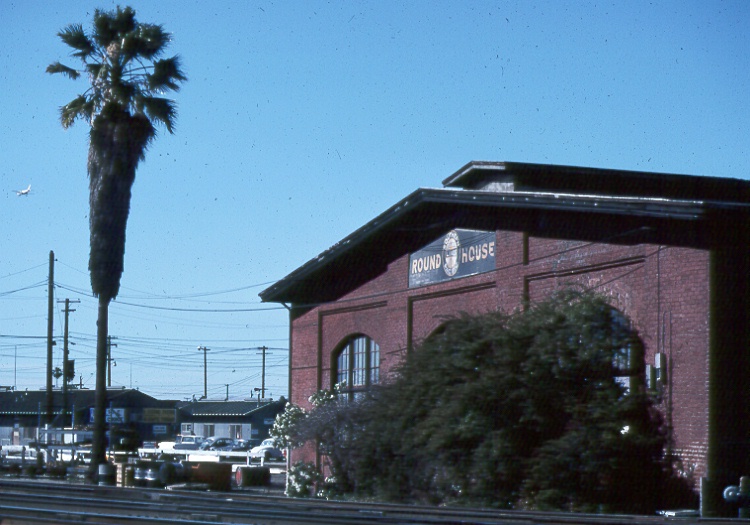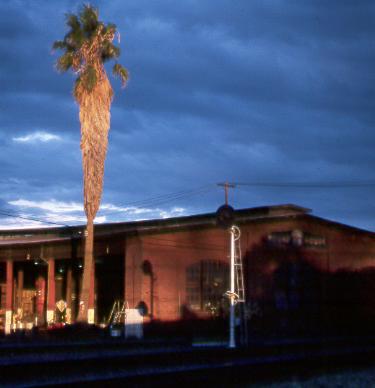
SAN JOSE ROUNDHOUSE
October 1993

The first train to San Jose on the San Francisco & San Jose Railroad arrived in January 1864 at the new passenger depot located downtown near Market and Basset Streets. The first locomotive facility was constructed nearby at San Pedro and Basset Streets. This was not a conventional roundhouse but rather a four-stall engine house.
 The
narrow-gauge South Pacific Coast Railroad arrived in San Jose from Alameda
in late 1877 and built a depot known as West San Jose at The Alameda, near
the present Amtrak/CalTrain depot. To service its narrow-gauge locomotives
the SPC built a three-stall engine house and a fuel yard north of the West
San Jose depot near what was once San Augustine Street.
The
narrow-gauge South Pacific Coast Railroad arrived in San Jose from Alameda
in late 1877 and built a depot known as West San Jose at The Alameda, near
the present Amtrak/CalTrain depot. To service its narrow-gauge locomotives
the SPC built a three-stall engine house and a fuel yard north of the West
San Jose depot near what was once San Augustine Street.
In March 1868 the SF&SJ was acquired by the original Southern Pacific Railroad, becoming Central Pacific's most serious rival on the western railroad transportation scene. Between March and September 1868 the Southern Pacific Railroad came under control of Central Pacific and on October 12, 1870 the Central Pacific incorporated the second Southern Pacific as a consolidation of the SF&SJ, the first Southern Pacific Railroad and the California Southern Railroad.
The South Pacific Coast Railroad was incorporated on March 25, 1876 to build a narrow-gauge railroad from Dumbarton Point, located near Newark, to San Jose, Los Gatos and Santa Cruz. The terminal at Dumbarton Point was inadequate, and as a result the line was extended to Alameda where ferry connections were made to San Francisco. The SPC was leased by Southern Pacific and formally incorporated by SP as the South Pacific Coast Railway on May 23, 1887.
The amount of traffic between San Jose and San Francisco was growing fast, and it wasn’t long before the four-stall engine house at Basset and San Pedro Streets was deemed too small to service the increasing number of locomotives showing up at its doorstep. With the narrow-gauge SPC now part of the Southern Pacific, a new brick roundhouse was built at Lenzen Avenue to accommodate the standard-gauge SP and narrow-gauge SPC locomotives. The actual date of construction is in doubt as several sources date the roundhouse at 1885, 1890 and 1893.
The new roundhouse was originally built with nine stalls, which were later increased to fifteen. Dual gauge track was laid at the roundhouse to accommodate both standard gauge and narrow gauge locomotives. This arrangement remained until about 1906 when the South Pacific Coast was standard gauged between Alameda, San Jose, Los Gatos and eventually Santa Cruz.
The original SPC wood engine house from San Augustine Street was modified and severed along its length then moved to Lenzen Avenue. Missing narrow gauge rails, this building served as a sand-drying house and engine crew ready-room, lasting beyond the end of the steam era. This building was razed in 1959 to make way for modernized diesel service facilities.
In 1916 the existing steam boilers were replaced with two boilers from retired A-2 class American-type locomotives. They were used to power shop machinery, heat oil and for steam cleaning. A three-chime steam whistle mounted on the
On December 31, 1935 the original main line through downtown San Jose on Fourth Street was abandoned and the new by-pass through the Willow Glen area was opened, along with the new passenger depot on Cahill Street. Steam lines were laid between the roundhouse and the new depot to provide steam heat for both the depot and commute cars, which were parked overnight awaiting early morning runs to San Francisco. After dieselization the steam boilers were retired and diesel generators from re-assigned locomotives were installed in a building west of the depot at The Alameda to provide steam heat. The diesel generators were retired when new headend CalTrain equipment replaced the last of the steam heated Harriman commute cars.
During the steam era a large number of employees worked out of the San Jose roundhouse. In addition to locomotive engineers and firemen reporting for commute trains, switchers and local freights, a large roster of boiler makers, machinists, laborers, herders and hostlers all worked under the direction of a roundhouse foreman. The roundhouse force worked 24-hours a day servicing the large number of steam locomotives assigned to San Jose.
Heavy repair and rebuilding of steam locomotives assigned to the Coast Division was handled at Bayshore Shops, with minor repairs and servicing being performed at local locomotive facilities. Additional Coast Division roundhouses were located at Mission Bay (in downtown San Francisco), Bayshore (in Brisbane), Watsonville Junction, San Luis Obispo and Santa Barbara.
 A
roundhouse was once located at Santa Cruz, however, it was dismantled in
December of 1942.
A
roundhouse was once located at Santa Cruz, however, it was dismantled in
December of 1942.
Motive power assigned to the San Francisco-San Jose commute pool, switch engines assigned to yard and industrial switching at San Jose, plus locomotives assigned to local freight trains were based out of the San Jose roundhouse. This included the 4-6-2s, 4-8-2s and 4-8-4s assigned to commute service, over a dozen 0-6-0 switchers which worked Newhall Street yard, the passenger depot, the North Yard (Santa Clara Yard), Fourth Street and West Side (Los Gatos Branch) industrial areas.
A number of 4-6-0 and 2-8-0 type locomotives were assigned to the Gilroy, Los Altos and Peninsula local freight runs, plus locals which operated on the Western Division to Oakland via Alviso and Milpitas. Road power assigned to through freight service was often changed out and serviced at San Jose. It was not uncommon to find 2-10-2s and Cab Forward locomotives steaming away on the ready track north of the roundhouse.
The 85-foot long air-operated balance-type turntable located at San Jose roundhouse prevented turning the larger steam locomotives. To accomplish this the 4-8-4s, 4-8-2s, 2-10-2s and 4-8-8-2s would be turned on the wye located behind and to the east of the roundhouse. Often, when several locomotives needed to be turned at the same time, hostlers would couple them together and haul them around the wye.
Dieselization And The End Of Steam
The first diesel switcher appeared in San Jose in 1947. On August 28, 1953 EMD SD-7 No. 5325 was assigned to commuter service as an experiment.. This locomotive lacked the get-up-and-go of the 4-8-4s and 4-8-2s which handled the long, fast peak hour commute trains, and as a result was assigned to midday and weekend commute runs, replacing a 4-6-2 which usually held this assignment. As the steam era drew to a close more and more diesel locomotives would find their way into commute service. In the early 1950s the few road diesel locomotives assigned to
By 1955 more and more EMD GP-9s were arriving on the property and the lines of retired steam locomotives were growing daily at West Oakland and Bayshore. On January 22, 1957 GS-4 No. 4430 pulled the last steam powered commute train from San Francisco to San Jose. Train No. 146 arrived in San Jose at 6:15 p.m. The big 4-8-4 was uncoupled from its train, hostled to the roundhouse for servicing, then turned on the wye before heading up a freight train to Oakland later that evening.
By now the commute service was firmly in the hands of GP-9s and Fairbanks-Morse 2400 horsepower Train Master diesel units. Alco and Fairbanks-Morse diesel switchers replaced the 0-6-0s and EMD and Alco road switchers replaced the 4-6-0s and 2-8-0s assigned to local freight service. In April and July 1957 a few isolated steam operations occurred on the SP, but the end of an era had arrived
In November 1959, with steam gone from San Jose, a large section of the San Jose roundhouse was torn down, leaving six stalls remained; only four stalls were used for locomotives, however. These surviving stalls were used for minor running repairs on power assigned to commute, switcher and local freight service out of San Jose. In October of 1989 the Loma Prieta earthquake did serious damage to the roundhouse, and after that it was no longer used for locomotive servicing and repair. Diesel locomotives continued to be serviced and fueled on the nearby storage and fueling tracks.
The End
On August 15, 1991 SP pulled all its locomotives out of the roundhouse area and moved them to Newhall Street yard where only minor servicing is now done. After that date the roundhouse was used exclusively to fuel and service CalTrain commute locomotives. When Amtrak took over the operation of CalTrain service on July 1, 1992 all CalTrain locomotive servicing was moved to Cahill Street, across from the San Jose Depot.
Today, the last SP Coast Division roundhouse
faces an uncertain future. Considered a historic landmark, one proposal
calls for moving the roundhouse to the Santa Clara County Fairgrounds at
Tully Road in San Jose. Another option calls for strengthening then restoring
the roundhouse at its current location as a historic railroad museum site.
BIBLIOGRAPHY:
PRUNE COUNTRY RAILROADING, Steel Trails
to San Jose
By Norman W. Holmes, published by Shade
Tree Books 1985.
SOUTH PACIFIC COAST
By Bruce A. MacGregor published by Howel-North
Books 1968.
A CENTENNIAL SOUTHERN PACIFIC COAST
By Bruce A. MacGregor and Richard
Truesdale, published by Pruett Publishing Company 1982.